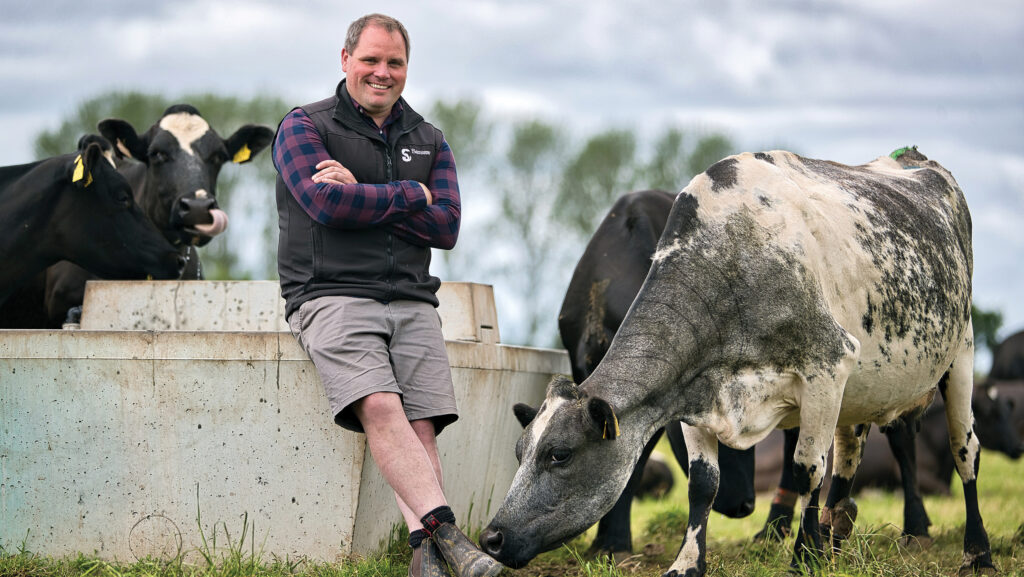2024 Farmers Weekly Awards: Meet the Finalists for Farm Manager of the Year

The finalists for this year’s awards represent distinct business models, each requiring diverse skill sets and the ability to navigate challenging conditions.
Explore more: Farm business insights from Farmers Weekly Award champions
Finalists
- Simon Andrews, Porchester Farms, Berkshire
- Breiffni Daly, Sansaw Dairies, Shropshire
The Judges
Richard Price has extensive experience in farm management and currently operates a consultancy, Ewematter, specializing in succession and business planning.
William Haupt, the 2023 Farm Manager of the Year for Farmers Weekly, oversees the 1,880ha farming operations at the Woburn Estate along with sizeable contract farming activities.
Suzie Horne has served as the business editor of Farmers Weekly since 2011 and is a former deputy editor of Big Farm Weekly.
Simon Andrews, Porchester Farms, Newbury, Berkshire

Simon Andrews © Kathy Horniblow
Simon Andrews operates in a stunning yet challenging terrain, characterized by exposed highlands, poor soils, and steep inclines.
Highclere Castle, a major tourist attraction, is located at the heart of the estate, placing the farm—and particularly the grazed parkland—under constant public scrutiny.
Initially joining as an assistant manager, Simon ascended to the managerial role nearly seven years ago, with priorities set on cost reduction and expanding the Highclere Castle Horse Feeds brand.
Transitioning the 1,400 ewe flock to New Zealand Romney cross Lleyn from North Country Mules and Suffolks, Simon shifted to outdoor lambing except in the case of triplets, employing permanent staff in place of contractors.
“Our intensive indoor lambing was underperforming,” Simon notes.
“A comprehensive investigation entailed blood testing for diseases, conducting worm egg counts, evaluating body condition scoring, and re-examining our procedures. We implemented rigorous culling and targeted lameness issues.”
In just three years, gross margin per ewe has doubled to £71, thanks to reduced labor costs, a significant cut in purchased feed, a thorough vaccination schedule, and decreased veterinary and medication expenses. The current yield is now 1.55 lambs per ewe, a rise from 1.2.
Innovations in Arable Farming
By investing in both new and refurbished machinery and moving away from energy-intensive equipment, Simon is successfully trialing innovative techniques without overspending.
Tractors are now cycled out every four years, backed by extended warranties, slashing machinery repair costs by 80% compared to four years ago, and minimizing downtime.
With the spraying now managed in-house and changes made to cultivation and crop rotations, the pressure from blackgrass, wild oats, and brome has been alleviated.
An expanded area of temporary grass for haylage has become the farm’s standout break crop, achieving a gross margin of £1,700/ha while also providing high-quality grazing for lambs and ewes before breeding season.
Focus on Value-Added Products
The objective is to increase direct sales to consumers, allowing the Highclere brand to dictate pricing rather than the marketplace.
Oats, aimed at the horse market, are the farm’s standout crop, prioritized during harvest.
Upon Simon’s arrival, wheat yields were stagnant, heavily reliant on saved Solstice seed. Shifting to varieties such as Crusoe and Zyatt has boosted yields while maintaining milling quality. Additionally, growing grain, barley, triticale, and beans for seed has added value. Spring barley is produced for distilling, and straw is sold to equine buyers for a premium.
A recently launched direct sales lamb box initiative has enhanced lamb margins. All wool from the farm is directed to high-value outlets, including exports to the U.S. via a Yorkshire processor, supplying bedding manufacturers in the U.S. for Highclere Castle branded mattresses.
Managing a Dedicated Team
Simon oversees a team comprising two tractor operators, a mill operator, and a shepherd, along with a college student on a placement one day per week. The farm shares a full-time secretary with the horse feeds business.
Under Simon’s guidance, extensive training programs have been implemented alongside refreshed employment documents and daily machinery maintenance logs.
The farm supports the upkeep of heritage buildings on the estate, including a recent restoration of a Grade 1 listed barn dating back to 1451.
Market Risks and Strategies
Simon is actively involved as a board member of the grain marketing co-op CMG and is increasingly utilizing buying groups for inputs and machinery rentals. Online platforms like Graindex and Sell My Livestock are leveraged for exploring new sales avenues for grain, straw, and livestock.
He participates in AHDB benchmarking and hosts tours for fellow farmers and school groups.
Key Figures
- 2,000ha estate
- 800ha of arable land
- 400ha of permanent pasture
- 1,400 ewes
- 230 clients for hay, haylage, and horse feed
- £1,229/ha gross margin for milling wheat in 2023
- £1,262/ha gross margin for winter malting barley in 2023
Farm Overview
- Significant arable operations plus contract farming across 200ha for a neighbor
- Large outdoor lambing operation
- Premium horse feed enterprise
- Contract grazing and maintenance services for local studs, including spraying for neighbors
- Small vineyard recently established
- Value-added strategy across all operations
- Engaged in stewardship programs, with a substantial new scheme recently agreed upon
- Project in progress to measure carbon sequestration by permanent pasture
What the Judges Appreciated
- Comprehensive understanding and responsibilities across various farming ventures and diversifications
- Able to juggle diverse demands and a varied crop portfolio
- Proactive in confronting challenges
- Aim for adding value and enhancing the estate brand
- Committed to continual improvement and evolution
Judges’ Comments
“Simon adeptly manages a complex and evolving business with poise and foresight, attuned to the estate’s needs and understanding the broader context within which the farming operation is pivotal.”
Breiffni Daly, Sansaw Dairies, Shrewsbury, Shropshire

Breiffni Daly © Richard Stanton
Breiffni began his journey at Sansaw Dairies in 2012, starting as a herdsman. After a stint in an equity partnership dairy enterprise in the Republic of Ireland, he returned to Sansaw in 2020 as the manager.
His primary challenges included scaling up cow numbers at the grass-based dairy from 1,200 to 1,500, enhancing technical efficiency, and restoring profitability.
Addressing high staffing needs and a previously elevated employee turnover rate also became crucial, necessitating a review of recruitment strategies and performance evaluations while nurturing the dairy team’s skills.
Breiffni faced challenges such as lameness and contagious mastitis, alongside improving genetics for pasture-produced milk and optimizing the use of slurry and environmental schemes.
His preferred breeding method features a mix of New Zealand Friesian, Irish Friesian, and Jersey, currently yielding an annual average of 4,800 liters of milk. He aims to elevate this to 5,200 liters over the next three to five years.
Breiffni identifies his key accomplishment as returning the dairy to a substantial profit. The farm’s milk, sold to Arla, boasts an average butterfat content of 4.98% and protein content of 3.82%, earning quality bonuses.
Forage contributes to 80% of milk production, supplemented by grown fodder beet and sourced maize, with Bactocan levels under Breiffni’s management ranging from 25,000 to 30,000 and somatic cell counts between 120,000 and 190,000.
Innovative Approaches
The dairy employs 14 full-time staff, augmented by nine during the high-demand spring calving season. Breiffni likens the peak calving period, spanning ten weeks from February to April, to “organized chaos,” with around 60 calves being born daily.
To streamline operations, he has implemented a staff management roster, assigning specific roles to each team member for two-week periods, boosting both efficiency and morale.
Additionally, Breiffni has established standardized operating procedures covering milking setup, hygiene, and calving processes.
Staffing Strategy
All farm workers are salaried, adhering to a 55-hour work week with an 11-days-on, three-days-off scheduling system. The plan for the next two weeks is communicated to everyone in advance to enhance transparency.
The operation has a clear structure, with designated managers responsible for herd management, young stock, grassland, and beef production.
Breiffni values collaborating through benchmarking groups, joining three distinct ones, each focusing on different aspects of the business, with managers participating actively.
Participating in events like Open Farm Sunday, Sansaw Dairies welcomes numerous visits from farmers, students, and various organizations.
Future Vision
Looking ahead, Breiffni envisions stabilizing cow numbers while reducing fertilizer use, increasing the inclusion of clover and herbal leys to enhance sustainability and environmental stewardship.
“We may not increase grass production significantly, which could result in lower stocking rates, but as we gradually regain more land, we will accomplish our goals,” he remarks.
Plans include planting hedges around fields at a pace of 1-2km annually.
Future considerations may involve shifting to autumn calving to capture seasonal payment incentives or prolonging spring calving.
Key Figures
- 1,520 cows in the herd
- 500 replacement calves
- 500 maiden heifers
- 1,000 beef calves (aged three to six months)
- 14 full-time staff members
- 190 paddocks in total
Farm Overview
- 820ha of spring-calving, grass-based dairy operation, milking twice daily
- State-of-the-art dairy facility (70-point rotary) established on a greenfield site in 2012
- Breeding program incorporates New Zealand Friesian, Irish Friesian, and Jersey
- 80% of milk sourced from forage—including grass, maize, and fodder beet
- Produces high-quality milk, averaging 4.98% butterfat and 3.82% protein, supplied to Arla
What the Judges Appreciated
- Dynamic energy and commitment to the business and staff leadership
- Thorough attention to operational details and safety protocols
- Expert in staff management—organization, retention, and motivation
- Strong financial acumen
- Comfortable operating at scale while pursuing business growth and exploring new prospects
Judges’ Comments
“Breiffni finds genuine joy in his work and remains open to change. He thoughtfully navigates the management of a large team while possessing a profound understanding of the business’s needs.”
A Message from Our Sponsor

“This award honors managers who skillfully lead their teams with expertise and vision, ensuring the safety of each worker and safeguarding the interests of their employer and the business they are nurturing.”
Oliver Dale, Managing Director, Safety Revolution

Maria Sanchez completed her Bachelor’s degree in Plant Sciences from the University of California, Davis, in the USA. Her studies focused on plant genetics and biotechnology, with an emphasis on developing disease-resistant crop varieties. Maria has contributed to several research projects aimed at improving crop resilience to climate change and is now pursuing her Master’s degree in Plant Breeding.
